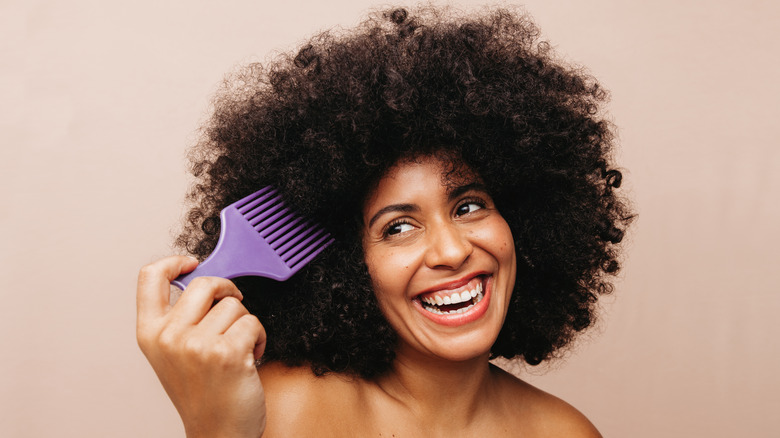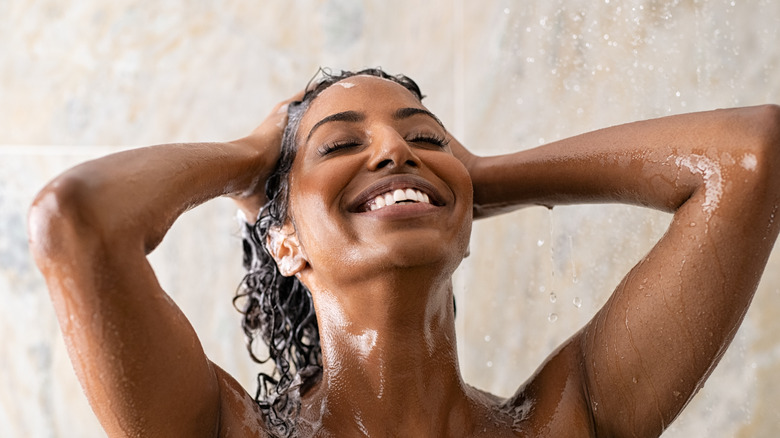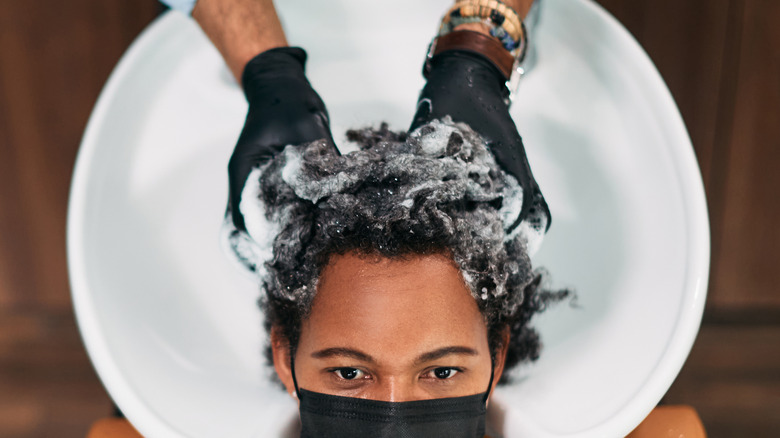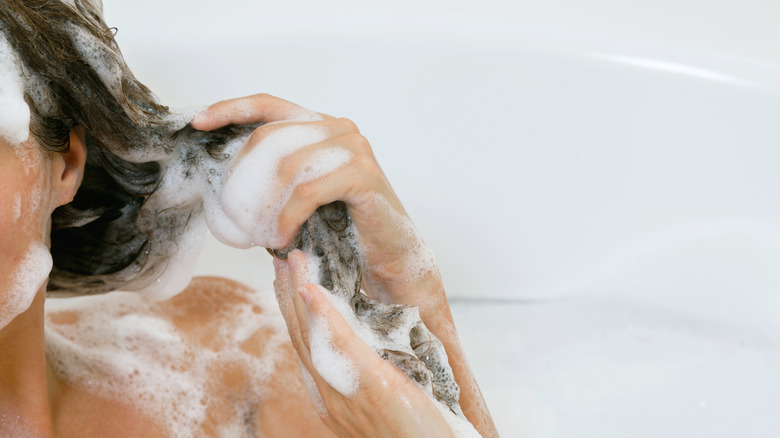The Drawbacks Of Co-Washing Your Natural Hair
For some, wash day is enjoyable, pleasurable, and sometimes fun. For others, wash day can be a bother — necessary but still a bother. These two groups and their experiences with such an essential part of hair care are polarizing, but they agree that wash day should always end with clean, lightweight, and healthy hair that feels good. However, for many people, wash day does not end with feel-good hair. Often, the issue is shampoo.
A major complaint with shampoo is how drying it can be and how it leaves hair feeling frizzy and flat, making it difficult to style or work with. This dryness is caused by the sulfates and some sulfonates most shampoos contain, specifically sodium lauryl sulfate, or SLS. Now, SLS is not all bad, as it removes oils and clears up the debris that can clog hair follicles. The issue is how harsh it can be. SLS can cause the hair's outer cuticle to open, removing the natural moisturizing factors in the hair (per Color Wow). No moisturizing factor equals dry hair, and dry hair is more prone to breakage. To avoid this, many turn to co-washing, which Hairstory confirms is short for conditioner-only washing or conditioner washing.
According to Coils and Glory, co-washing is a method of washing hair with just conditioner. Since there is no shampoo used, co-washing is also called the no-poo method. As it turns out, though, it might not be the best for your scalp.
How does co-washing work?
Unlike shampoo, which dries out your hair by stripping it of its natural oils, conditioner softens and moisturizes. Conditioner's gentler cleansing effect makes co-washing excellent for people with dry hair, particularly those with kinkier hair textures like 4C. Moisturizing your hair by conditioning also helps with length retention by reducing breakage. It's a pretty neat 2-in-1 deal: good hair and long hair.
To do this, start by finding the best co-wash for you. You could use a regular conditioner or one specially made for co-washing. Carol's Daughter says to look for co-washes or conditioners with humectants and emollients. Humectants like glycerin, sorbitol, and urea attract water molecules to your hair, while emollients smoothen the cuticle and soothe dryness. We recommend the Mielle Organics Detangling Co-Wash, and the Briogeo Curl Charisma Rice Amino + Shea Hydrating Co-wash. Another thing to look out for is silicones which are known for causing buildup in the hair, causing strands to appear flat and lackluster. As co-washing isn't as vigorous with cleaning your hair as regular shampoo is, Healthline says it's best to avoid any co-washes that cause product buildup.
How to co-wash
According to Carol's Daughter, start by rinsing your hair with water to drench it. If your hair is on the fuller end, divide it into sections and rinse to ensure all parts are wet. Then, apply a small dollop of your co-washing cleanser or conditioner on your hair. You can go in with more co-wash until your hair — root to tip — is appropriately coated with the product. You can also detangle and spray your hair with some more water while you're at it.
Next up, Ethique says to massage your scalp really well to get the dirt off your roots. Since this is a no-shampoo wash, massaging well using your fingertips or a scalp massager is essential to shake off the dirt and debris. After massaging, rinse off the co-wash. Then, if you don't feel clean enough, you can rinse your hair once again, apply the co-wash, and gently massage your scalp (per Curlsmith).
So far, co-washing might seem like a dream come true, especially for natural hair enthusiasts. But it's not all rainbows here, as this method can have some downsides.
The drawbacks of co-washing
We know — it all sounds too good to be true, and that's because it can be. The conditioner-only rule isn't the only thing that makes co-washing different from regular wash day using shampoo. There's also the need for friction in co-washing. Because surfactants or detergent compounds like sodium lauryl sulfate are not utilized in co-washing, removing dirt, oil, and buildup from your hair depends on how well you scrub your roots and scalp. Of course, this is not as effective as shampoo, so you might experience buildup. Constant buildup means your hair may take on a dull appearance.
Other drawbacks of conditioner-only washing include an itchy scalp and the risk of causing or aggravating contact dermatitis. As Afrocenchix explains, these issues can occur due to scalp irritation caused by product buildup. To help with these, Prose recommends washing your hair with a clarifying shampoo once a week or once every other week. Also, co-washing regularly is probably not a good fit for you if you have fine, straight hair. The constant use of conditioner can weigh down your strands (per Mecca).
Co-washing is a fantastic way to retain length and add some much-needed moisture and softness to your hair. But because this method can come with potential downsides, you might want to consider adding in a shampoo every now and then.



